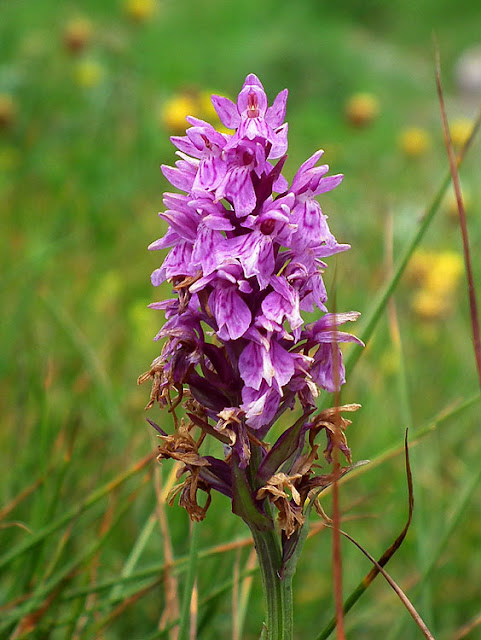Scorpion Flies are weird looking predatory insects with long spotted wings and a stabbing mouth called a rostrum. The males also have an appendage on the tip of their abdomen which they curl up over their back, scorpion fashion. Despite their English name they are not flies at all, but a separate order of their own, called Mecoptera.
 |
| Female scorpion fly Panorpa sp (Fr. Panorpe). |
Normally they don't do much in the way of impressive hunting, the way dragonflies and robber flies do. Scorpion Flies mostly eat already deceased insects. With their rostrum they will also suck up nectar sometimes. They are completely harmless to humans.
According to a report I read recently, they are known to hang out on orchids, especially marsh orchids Dactylorrhiza spp, laying in wait for unsuspecting insect visitors coming for the generous nectar that some orchids offer.
 |
| Heath Spotted Orchid Dactylorhiza maculata (Fr. Dactylorhize maculé). |
Dactylorhiza have pinky purple flowers and labella (lower petals) with dark stripes to direct insects to the landing patch. But they are swindlers. There is no nectar to reward the insect, despite the signs the orchid displays. They need the insects as pollinators though, and practice this clever deception to get what they need without expending too much energy on nectar production.
 |
| Broad-leaved Helleborine Epipactis helleborine (Fr. Epipactis à larges feuilles). |
The insects which come to orchids are often flies, and so they are the most common victims of the Scorpion Flies. The orchid stigmas are coated in a sticky sugary substance which is attractive and nutritious for the flies, but it is also a trap. In hot weather it ferments and the flies become drowsy, drunken and sometimes stuck inside the orchid flowers, making them easy prey for the Scorpion Flies. Even if the fly is inside the orchid flower the Scorpion Fly can access them with their strong rostrum, and if necessary chew or bore through the orchid to get at the fly.
 |
| Heath Spotted Orchid Dactylorhiza maculata (Fr. Dactylorhize maculé). |
Orchids also host spiders which will prey on insect visitors too. The Scorpion Flies have been known to simply steal prey from spider webs on orchids. If the orchid in question is one that gives nectar, such as Broad-leaved Helleborine Epipactis helleborine, the Scorpion Flies will suck up nectar. Once again the orchid is laying a trap, but this time it is because the nectar is alcoholic and narcotic. Anything that sucks it up, including the Scorpion Flies, will end up addicted in a very short space of time.
 |
| Common Spotted Orchid Dactylorhiza fuchsii (Fr. Orchis de Fuchs). |
Orchids, particularly Helleborines Epipactis spp, are often infested with aphids, and these are often predated by Scorpion Flies. The aphids destroy the orchid flowers while they are still at the bud stage, so in this respect the Scorpion Flies are the orchids' ally.

No comments:
Post a Comment